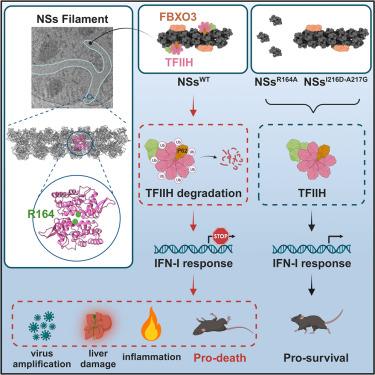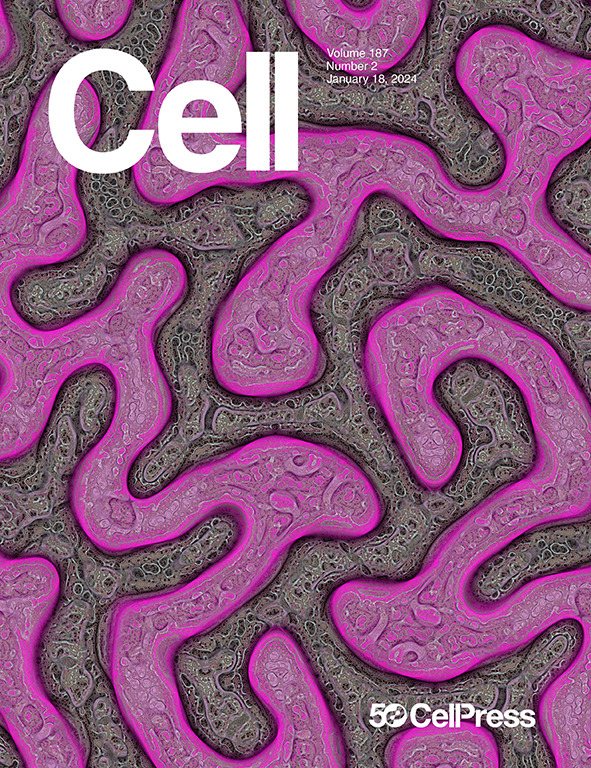裂谷热病毒协调可编程 E3 连接酶的组装以促进病毒复制
IF 45.5
1区 生物学
Q1 BIOCHEMISTRY & MOLECULAR BIOLOGY
引用次数: 0
摘要
病毒编码降解细胞蛋白的策略,以促进感染和致病。在这里,我们揭示了裂谷热病毒的非结构蛋白 NSs 可形成丝状 E3 连接酶,从而引发目标蛋白的高效降解。体外重构和 2.9 Å 分辨率的冷冻电镜分析表明,NSs 形成右手螺旋状纤维。NSs丝状寡聚体与细胞中的FBXO3结合形成重塑的E3连接酶。NSs-FBXO3 E3连接酶通过NSs-P62相互作用靶向细胞TFIIH复合物,导致TFIIH复合物泛素化和蛋白酶体依赖性降解。NSs-FBXO3 触发的 TFIIH 复合物降解导致了抗病毒免疫的强力抑制,并促进了病毒在体内的发病。此外,研究还表明,NSs可被编程为靶向蛋白酶体依赖性降解的其他蛋白质,是一种多功能靶向蛋白质降解器。这些结果表明,一种毒力因子形成了丝状的可编程降解机制,诱导细胞蛋白质的有组织降解,从而促进病毒感染。本文章由计算机程序翻译,如有差异,请以英文原文为准。

Rift Valley fever virus coordinates the assembly of a programmable E3 ligase to promote viral replication
Viruses encode strategies to degrade cellular proteins to promote infection and pathogenesis. Here, we revealed that the non-structural protein NSs of Rift Valley fever virus forms a filamentous E3 ligase to trigger efficient degradation of targeted proteins. Reconstitution in vitro and cryoelectron microscopy analysis with the 2.9-Å resolution revealed that NSs forms right-handed helical fibrils. The NSs filamentous oligomers associate with the cellular FBXO3 to form a remodeled E3 ligase. The NSs-FBXO3 E3 ligase targets the cellular TFIIH complex through the NSs-P62 interaction, leading to ubiquitination and proteasome-dependent degradation of the TFIIH complex. NSs-FBXO3-triggered TFIIH complex degradation resulted in robust inhibition of antiviral immunity and promoted viral pathogenesis in vivo. Furthermore, it is demonstrated that NSs can be programmed to target additional proteins for proteasome-dependent degradation, serving as a versatile targeted protein degrader. These results showed that a virulence factor forms a filamentous and programmable degradation machinery to induce organized degradation of cellular proteins to promote viral infection.
求助全文
通过发布文献求助,成功后即可免费获取论文全文。
去求助
来源期刊

Cell
生物-生化与分子生物学
CiteScore
110.00
自引率
0.80%
发文量
396
审稿时长
2 months
期刊介绍:
Cells is an international, peer-reviewed, open access journal that focuses on cell biology, molecular biology, and biophysics. It is affiliated with several societies, including the Spanish Society for Biochemistry and Molecular Biology (SEBBM), Nordic Autophagy Society (NAS), Spanish Society of Hematology and Hemotherapy (SEHH), and Society for Regenerative Medicine (Russian Federation) (RPO).
The journal publishes research findings of significant importance in various areas of experimental biology, such as cell biology, molecular biology, neuroscience, immunology, virology, microbiology, cancer, human genetics, systems biology, signaling, and disease mechanisms and therapeutics. The primary criterion for considering papers is whether the results contribute to significant conceptual advances or raise thought-provoking questions and hypotheses related to interesting and important biological inquiries.
In addition to primary research articles presented in four formats, Cells also features review and opinion articles in its "leading edge" section, discussing recent research advancements and topics of interest to its wide readership.
 求助内容:
求助内容: 应助结果提醒方式:
应助结果提醒方式:


